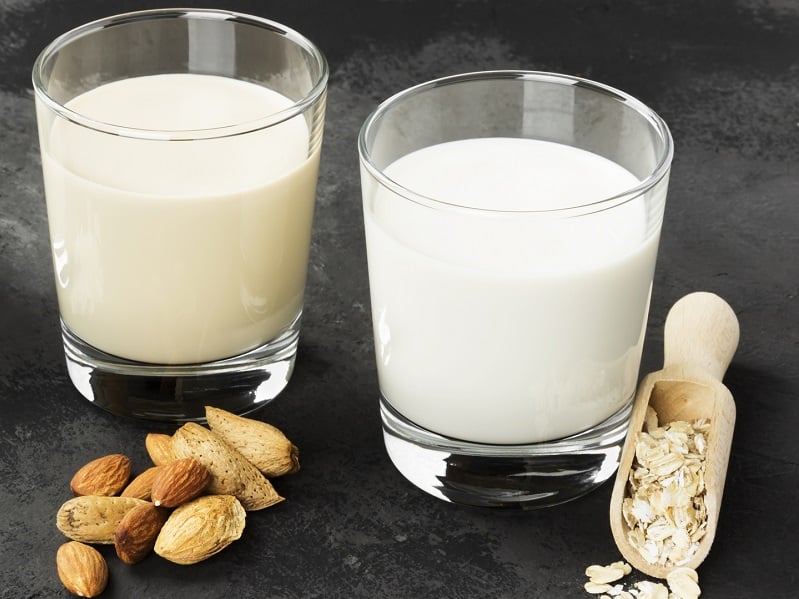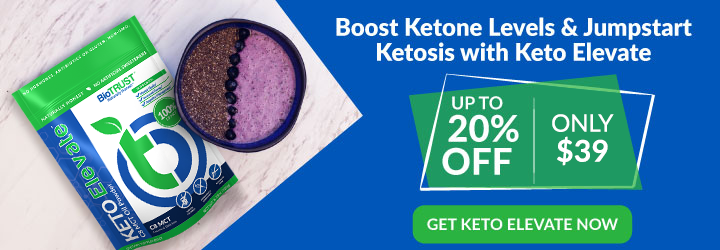Oat Milk vs. Almond Milk: Which is Better For You?

Whether it’s mixed into your morning latte, overnight oats, or added to baked goods, cow’s cream, or milk, is increasingly being pushed aside for plant-based alternatives. At first, soy milk was the only alternative readily available. Then the whole category went a little nutty—with coconut, macadamia nut, cashew, and of course, almond milk leading the pack. Now, more milk alternatives are hitting the shelves, like oat milk, which is gaining popularity as it’s plant-based, sustainable, naturally sweet, and surprisingly creamy. But when it comes to nutrition, which option is the cream of the crop? Let’s look at two of the top options in today’s food faceoff: oat milk vs. almond milk.
In today’s faceoff of oat milk vs almond milk, we will cover the following:
Oat Milk vs. Almond Milk: Nutrition
Yes, oat milk and almond milk are both plant-based milk alternatives. But that’s basically the end when it comes to similarities. These two milk alternatives are pretty different nutritionally. A one-cup serving of each provides (depending on the brand):
Oat Milk Nutrition Facts:
- Calories: 80
- Fat: 1.5g
- Saturated Fat: 0g
- Sodium: 120mg
- Carbs: 14g
- Sugar: 1g
- Fiber: 2g
- Protein: 3g
Almond Milk Nutrition Facts1:
- Calories: 37
- Fat: 2.3g
- Saturated Fat: 0g
- Sodium: 160mg
- Carbs: 3g
- Sugar: 2g
- Fiber: .5g
- Protein: 1g
For comparison, cow’s milk is higher in calories (150), fat (8 g), carbohydrates (12 g), sugars (11 g), and protein (8 g) than either of the options above.
While it makes sense that oat milk is higher in carbohydrates, you may be surprised to learn that oat milk provides more protein, more fiber, and less sodium than almond milk. Just be sure you opt for unsweetened milk alternatives, as sweetened versions can provide a plethora of added sugar. Almond milk is also more likely to be sweetened as it isn’t naturally as sweet as oat milk.
Naturally, almond milk also provides a good amount of vitamin E, an important nutrient for the skin and immune system. On the other hand, oat milk is a good source of the soluble fiber beta-glucan, which has a wealth of health benefits, including supporting a healthy gut, and helping reduce cholesterol. (For this benefit, look for the least processed oat milk or make your own.)
But, if you are gluten-intolerant, you’ll want to watch how your oat milk is produced. While oats are naturally gluten-free, oats are often processed near other grains, making cross-contamination a concern.
Oat Milk vs. Almond Milk: Sustainability
There has been a lot of controversy regarding the amount of water used to grow almonds with some reports suggesting it takes 1,900 gallons (or more) per pound. And unfortunately, the areas where almonds grow (e.g., California) are experiencing severe droughts. In this case, oat milk would win this category, hands down. However, California farmers have begun implementing innovations to drastically decrease the water footprint for producing almonds. Even so, almonds do have a larger water footprint than many other crops.
Oats, however, take more land to grow, so they may have environmental impacts as well. Both plant-based milks, though, have a solid edge when compared to conventionally produced cow’s milk. (Organic regenerative agriculture may help even out the playing field.)
Oat Milk vs. Almond Milk: Taste & Versatility
If your top consideration for your milk alternative is creaminess, then oat milk is the clear winner. Overall, oat milk is the most similar to cow’s milk in terms of its smooth and creamy taste and texture. It works well in smoothies, lattes, cream-based soups, and of course, overnight oats. It can even froth like cow’s milk, making it a favorite alternative among baristas as well as bakers.
Almond milk is also highly versatile. It just isn’t as creamy and can be on the watery side. Almond milk often has a thickener like carrageenan added, which oat milk simply doesn’t need. Yet oat milk, as mentioned above, is higher in calories and carbs.
Oat Milk vs. Almond Milk: Store-Bought vs. Homemade
Both oat milk and almond milk are made by soaking oats or almonds in water, followed by blending and then straining out the solids, to leave the milky-colored fluid. If purchasing store-bought products, you’ll typically find additional ingredients. While some are good…others are not so good. For example, both oat and almond milk are often fortified with calcium and vitamin D, as well as A, B2, and B12.
We’ve previously mentioned carrageenan, which is a common additive in almond milk. It’s used to help thicken and prevent separation in almond milk, but it does come with concerns. This ingredient is made from edible red seaweed and has been used for hundreds of years. It’s now a common additive in ice cream, non-dairy milks (as it’s vegan), pudding, and soft cheeses.
While many researchers and food manufacturers suggest carrageenan is safe, others have suggested it may increase inflammation and damage the gut. Some have even suggested there may be an association with colitis, IBS, rheumatoid arthritis, and disease in the colon in animal studies with carrageenan. The research, however, is far from conclusive. In other words, we don’t yet know whether carrageenan deserves its unsavory reputation or not. 2,3 If you are concerned, though, it’s not too hard to find brands without added carrageenan, such as Califia Farms Unsweetened Almond Milk or Malk Unsweetened Almond Milk.
If you want to skip the additives altogether, both almond milk and oat milk are easy to make at home.
To make almond milk: start by soaking a cup of raw almonds for at least 12 hours. (The longer they’re soaked, the creamier the milk.) Drain the water and then place the almonds in a blender with 3 cups of water and blend for at least 1 minute—starting at a low speed and moving up to a higher speed. Pour the mixture through cheesecloth or a nut milk bag, strain off the liquid, and save the spent almonds for a future recipe. If you want a sweeter milk, you can pour the “milk” back into a blender and add a pinch of sea salt and your favorite sweetener (such as stevia, honey, or maple syrup) and blend until smooth.
To make oat milk: combine 1.5 cups of organic steel-cut or regular oats with 4 cups of cold water and blend for about a minute. With a fine-mesh strainer, nut milk bag, or cheesecloth, strain out the “milk,” and it’s ready to use.
The biggest drawback to making your own alternative milk is that it won’t be fortified with nutrients like calcium, vitamin D, or vitamin B12. However, those nutrients are widely available in other foods as well as in supplements. So, if you consume a balanced diet, this shouldn’t be a big concern.
Oat Milk vs. Almond Milk: Which One Should You Choose?
As with many food options, there are pros and cons on both sides. So, at the end of the day, it comes down to personal preference.
Of course, if you have any nut allergies, you’ll want to choose oat milk. If you are on a low-carb diet or are sensitive to gluten, you’ll want to either be careful with the oat milk you choose or simply pick almond milk.
Whichever one you choose, you can substitute it one to one to replace dairy milk in coffee, smoothies, baked goods, ice cream, and anywhere else you could typically use milk.





 7 Signs Your Body is Seriously Low on Collagen (not just wrinkles)
7 Signs Your Body is Seriously Low on Collagen (not just wrinkles) Health Expert: "Turmeric Doesn't Work (unless...)"
Health Expert: "Turmeric Doesn't Work (unless...)" 3 Warning Signs Your Probiotic Supplement is a Total Waste
3 Warning Signs Your Probiotic Supplement is a Total Waste

